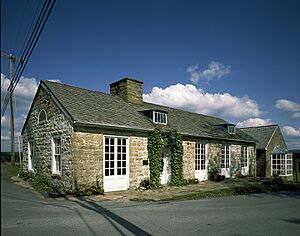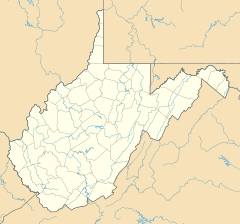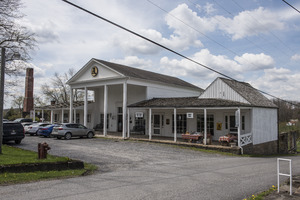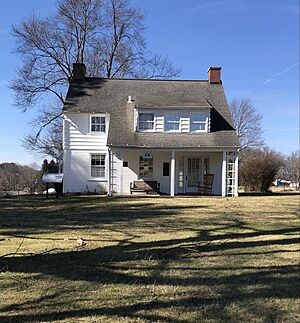Arthurdale, West Virginia facts for kids
Quick facts for kids
Arthurdale, West Virginia
|
|
|---|---|

Administration building
|
|
| Country | United States |
| State | West Virginia |
| County | Preston |
| Elevation | 1,775 ft (541 m) |
| Time zone | UTC-5 (Eastern (EST)) |
| • Summer (DST) | UTC-4 (EDT) |
| GNIS feature ID | 1553753 |
|
Arthurdale Historic District
|
|
| Location | E and W of WV 92, Arthurdale, West Virginia |
| Area | 1,102 acres (446 ha) |
| Built | 1933 |
| Architect | Gugler, Eric; Wagner, Stewart |
| NRHP reference No. | 88001862 |
| Added to NRHP | February 1, 1989 |
Arthurdale is a small community in Preston County, West Virginia, United States. It was built in 1933 during the Great Depression. The idea was to create a new kind of town. It aimed to help miners and farmers who had lost their jobs.
This special project was led by the government's Subsistence Homesteads Division. First Lady Eleanor Roosevelt was very involved. She used her influence to make sure the project got government approval. The goal was to help people become self-sufficient. This meant they would rely less on outside markets or government help.
Arthurdale faced challenges because of different ideas about how it should work. Some wanted to help the neediest people. Others wanted to pick only those who could make the community successful. The idea of a strong community spirit didn't fully take hold. Many people remember Arthurdale as a project that didn't quite succeed. However, some original residents still believed in its goals. Today, Arthurdale is a historic district. More than 100 of its original buildings still stand. There is also a New Deal museum there.
Building a New Town
Arthurdale got its name from Richard Arthur. He used to own the land where the town was built. He sold the land to the government because of unpaid taxes. Building work started at the end of 1933. It quickly became clear that Arthurdale was very important to Eleanor Roosevelt.
She worked hard to make sure the homes had modern features. These included good insulation and indoor plumbing. Eleanor even personally chose the refrigerators for each house. For a while, she acted like a manager for Arthurdale. She found people who could bring jobs to the community. She also helped raise money and keep an eye on the budgets. Roosevelt spent much of her own money on the project at first. A rich helper named Bernard Baruch also gave a lot of money.
On October 12, 1933, the government announced the land purchase. They said Arthurdale would be a "demonstration project." It would help coal miners who were out of work. Each family would get a simple home and enough land. This land would allow them to grow their own food and crops. Each home was planned to cost about $2,000. The community was supposed to govern itself, like small towns in New England. There were no private jobs planned at first. Only a factory that made equipment for the U.S. Post Office was expected.
Challenges and Changes
Eleanor Roosevelt saw Arthurdale as an exciting new chance. She believed the government could help struggling citizens build successful lives. But the project soon ran into money and political problems. Building and running Arthurdale cost much more than the government expected. Also, the idea of government-planned communities was not popular with everyone.
Some people called it "socialist" or a "communist plot." Others in Congress didn't like the government competing with private businesses. A US Senator named Thomas Schall even accused Roosevelt of unfair practices. He claimed her name was on furniture made there, sold for too much money.
Choosing the first families for Arthurdale was also difficult. Professors from West Virginia University were in charge of picking them. They wanted to help people who truly needed it. But they also wanted to choose people who would make the project a success. They looked for people with good character who could contribute. The government also wanted the first families to be smart and capable. This was because only certain kinds of people could make the experiment work.
In the fall of 1933, they started picking the first 50 families. Most importantly, applicants needed to know how to farm. By October, over 600 applications had come in. Besides farming knowledge, families needed to be healthy. They also needed a certain education and intelligence level. They had to show they could succeed at Arthurdale. The process included an eight-page questionnaire and interviews. People were also interviewed in their homes. They were asked about their family's health and stability.

Because of these rules, most of Arthurdale's first families were white, married couples. They either had children or wanted to have them. Single people and immigrants were usually not chosen. Single people were thought to contribute less to community life. Immigrants were sometimes seen as lacking the English skills needed. Many local people wanted Arthurdale to be only for white families. Mrs. Roosevelt disagreed with this idea. But she let the local project leaders decide. After a community vote, she suggested creating other communities for black and Jewish miners. This experience made Roosevelt speak out more strongly against unfair treatment. In many New Deal projects, local leaders had a lot of power. Even though laws were federal, local people put them into action. Arthurdale was not the only place where local attitudes about fairness were a challenge.
In 1938, President Franklin D. Roosevelt gave a speech at Arthurdale's high school graduation. This was the only high school graduation speech he gave as president. Eleanor Roosevelt visited the area often. She went to graduations, dances, and other events. But she also checked on the building progress. When the community struggled to attract businesses, Roosevelt helped. She arranged for General Electric to open a factory there. General Electric didn't stay long. But other businesses tried to set up shop in Arthurdale. These included companies making vacuum cleaners, faucets, and tractors. Military supply companies also came. Only the Sterling Faucet company stayed for a long time. Also, most families found it hard to grow enough food for themselves. Many still needed government help.
The Subsistence Homesteads Division was created in August 1933. But it was closed in May 1935. Its work was moved to the Resettlement Administration. This showed that the government's focus was changing. They were moving from small homesteads to larger suburban "greenbelt cities."
Decline and Legacy
By the late 1930s, Arthurdale had lost much support in Washington. Even though Roosevelt strongly supported the project, she couldn't stop Congress from giving up on it. Roosevelt herself was "deeply disappointed" after a visit in 1940. She saw that the community had become too dependent on the government. It lacked its own independent spirit.
As the United States prepared for World War II, Arthurdale's ideas became less important. In 1941, Arthurdale was sold back to private owners. Property was sold to the families living there and to other buyers. The government lost money on these sales. Arthurdale still received some government money and had a federal manager until 1947.
For many reasons, the Arthurdale project is often called a failure. However, Eleanor Roosevelt personally thought it was a success. She later spoke about the many improvements she saw in people's lives there. She once said, "I don't know whether you think that is worth half a million dollars. But I do." Eleanor Roosevelt returned to Arthurdale for the last time in 1960. She spoke at the opening of a new Presbyterian Church.
One original resident, Glenna Williams, said in 1984, "I can't see how some people call Arthurdale a failure. It's a wonderful place to live." The community still exists today. Many of the original buildings are still used more than eighty years later. A non-profit group called Arthurdale Heritage, Inc. was formed in 1985. They bought several buildings. This group continues to protect and restore the town. The New Deal Museum there is open all year.
Arthurdale Today
Arthurdale is now a national historic district. It includes 147 important buildings, one structure, and one site. It is important because when it was listed, all 165 houses were still standing. Also, the Inn, four of the six factories, the pottery, well house, cemeteries, most community center buildings, and the original roads were still there. It was added to the National Register of Historic Places in 1989.
See also
 In Spanish: Arthurdale (Virginia Occidental) para niños
In Spanish: Arthurdale (Virginia Occidental) para niños




